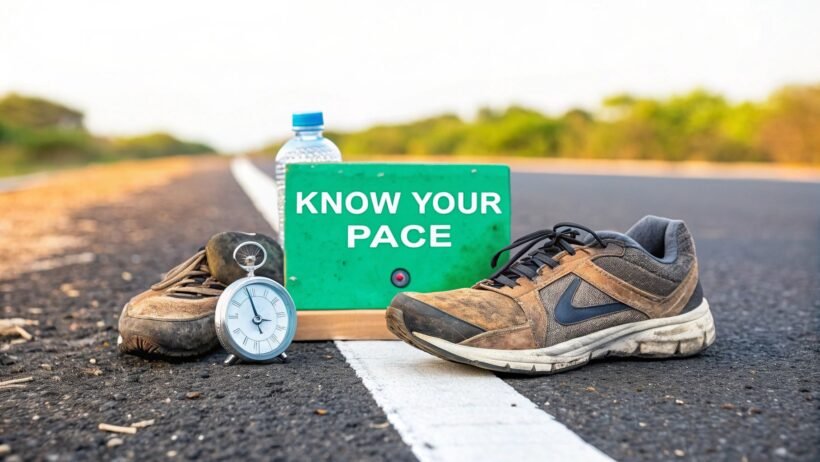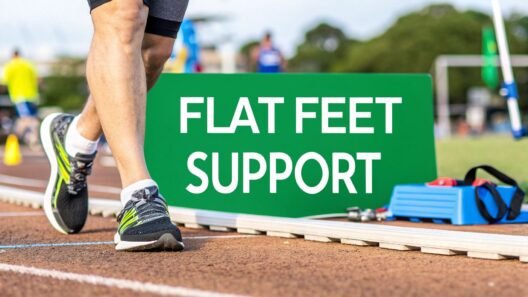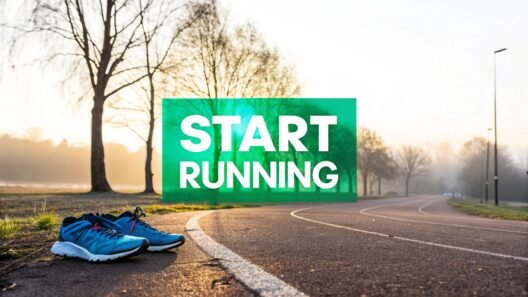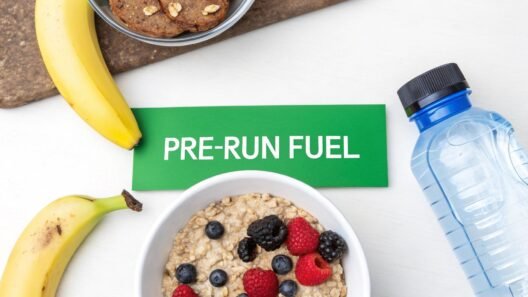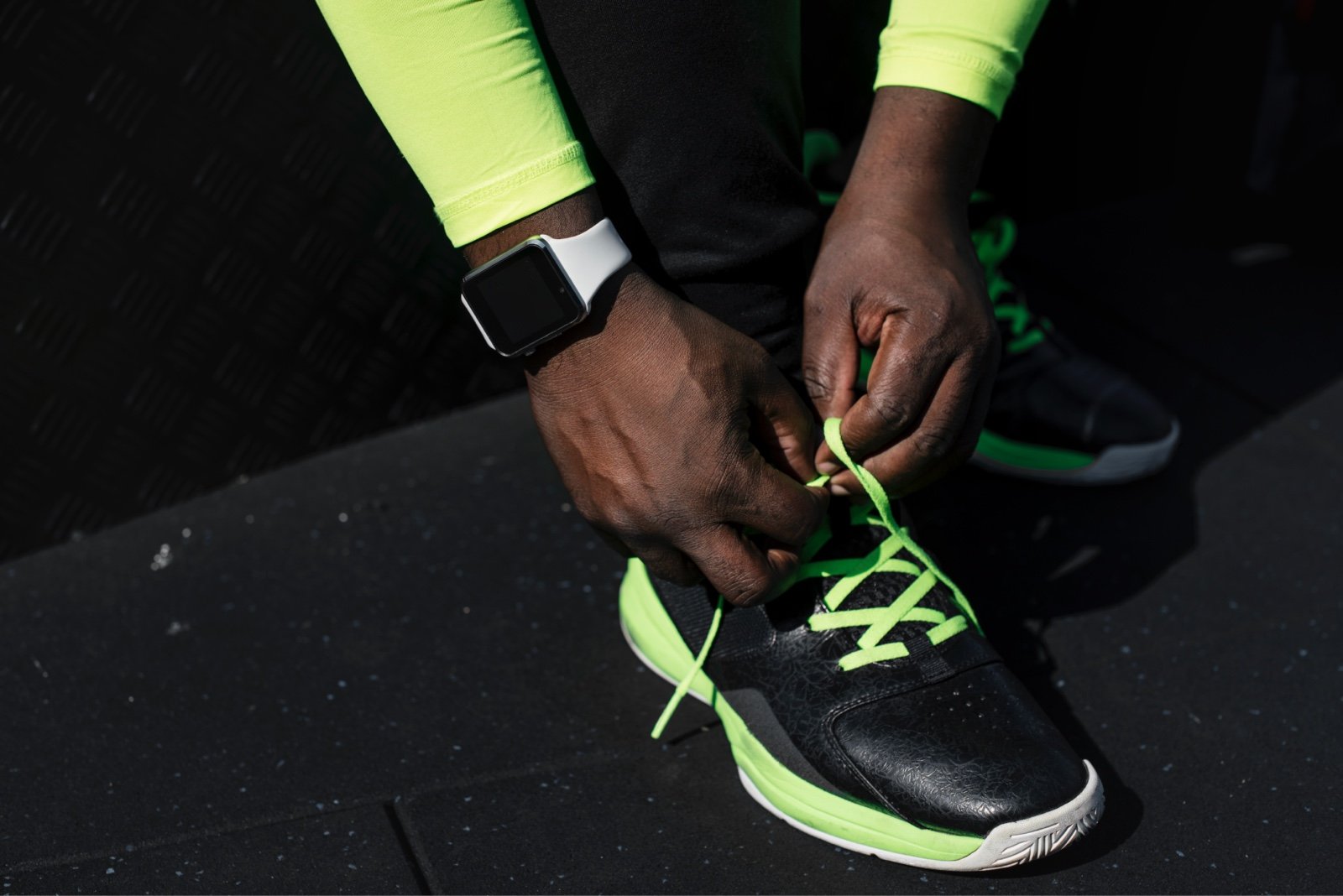So, what's a "good" half marathon time? The simple answer is that the average time globally is around 2 hours, 14 minutes, and 59 seconds. But that number is just the starting line.
The truth is, asking about a "good" time is really about finding a benchmark for your own potential. Think of that global average less as a rigid standard and more as a helpful landmark on your personal running journey. It’s a reference point, not a rule.
A huge study analyzing 35 million race results across the globe pinned the average time to run 13.1 miles at 2:14:59. This gives us a fantastic, real-world snapshot of what the everyday runner can expect to achieve on race day.
Global Average Half Marathon Times at a Glance
To get a clearer picture, it helps to see how these times break down between men and women. On average, men tend to run faster due to physiological factors like muscle mass and oxygen-carrying capacity. Knowing this helps you set goals that are both challenging and realistic.
Here's a quick look at the average finish times.
| Category | Average Time |
|---|---|
| Male Runners | 1:59:48 |
| Female Runners | 2:24:03 |
These numbers provide some great context for your own goals. For many guys, dipping under that two-hour mark means they're officially faster than about half of their fellow male runners. For women, finishing under two hours is a massive accomplishment, placing them solidly in the top 20% of female racers.
The real measure of a "good" time isn't how you stack up against others, but how you improve on your own past performances. Every personal best is a victory worth celebrating.
Moving Beyond the Average
While these stats are interesting, remember they blend together every type of runner imaginable—from the first-timer just hoping to cross the finish line to the dedicated amateur chasing a new personal record.
Here's a motivating stat: an impressive 45% of all runners finish the half marathon in under two hours. This shows that the classic "sub-2:00" goal is very much within reach for a lot of people who put in the work.
Ultimately, use these averages as a starting point, not a finish line. They give you valuable context, but they don't define what you're capable of. Your training, dedication, and personal journey are what will truly shape your success. As we dig deeper, you'll see how factors like age and experience paint a much more detailed picture of what a great performance looks like.
How Finish Times Change with Age and Gender
When someone asks, "What's an average half marathon time?" there's no single, simple answer. It’s a lot like asking "how fast is a car?"—it completely depends on the model, its age, and what it’s built for. A runner's finish time is just as personal, and it's deeply connected to individual factors like age and gender.
To get a sense of the big picture, we can look at data from real runners. One massive analysis of over 124,000 race results found the global average half marathon time is right around 1 hour, 50 minutes, and 15 seconds. That’s a great starting point, but the truly useful insights emerge when we start slicing up the data. If you love digging into numbers, you can find more detailed race time statistics on Marathon Handbook.
Drilling down a bit, we see that an average time for men is approximately 1 hour, 43 minutes, and 33 seconds, while for women, it's closer to 2 hours and 12 seconds. These aren't arbitrary numbers; they reflect real physiological differences in things like aerobic capacity, muscle mass, and even hormone levels, all of which play a part in running economy.
This infographic lays out the global averages clearly.
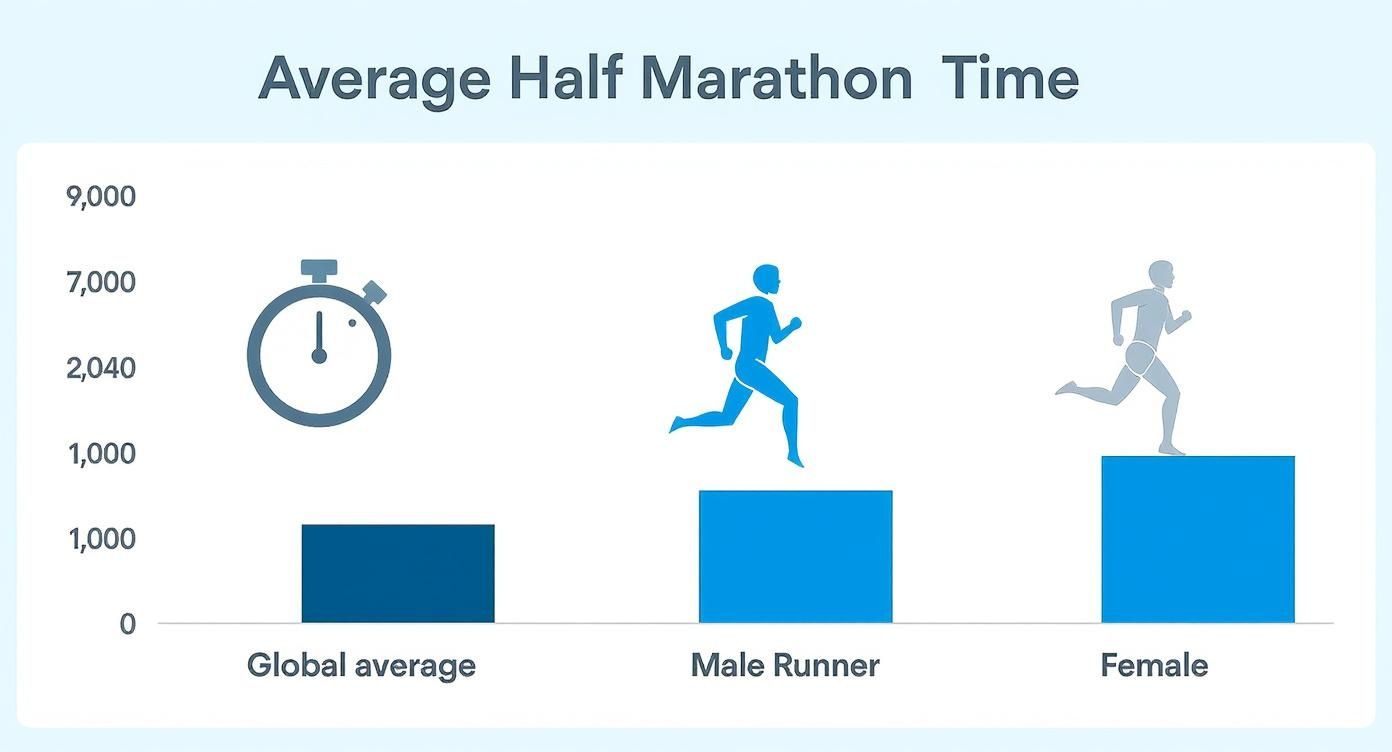
Seeing it visually drives home why context is so important. Comparing yourself to the overall average is one thing, but stacking your time against your specific gender provides a much more meaningful benchmark.
The Role of Age in Running Performance
Age is the other big piece of the puzzle. It’s no secret that our bodies in our 20s are different from our bodies in our 50s, and our running potential naturally shifts along with them. Generally speaking, most runners find their peak performance window somewhere between their late 20s and late 30s.
This is often the sweet spot where athletes have built a solid aerobic base while still holding onto plenty of muscular power and speed. But this definitely doesn't mean your best running days are behind you once you hit 40. Not even close.
Endurance can continue to develop for many years. While top-end speed may naturally decline with age, the ability to sustain a strong pace over long distances often improves with consistent, intelligent training well into a runner's 40s and 50s.
This is exactly why you see so many master runners—those over 40—posting incredibly impressive half marathon times. What they might have lost in raw speed, they've more than made up for with years of accumulated training, disciplined pacing, and rock-solid mental fortitude.
Average Half Marathon Finish Times by Age Group and Gender
To give you a clearer picture of what to expect at different stages of life, we’ve broken down the average half marathon times across various age groups. Think of this table not as a set of rigid rules, but as a helpful guide for setting goals that are both challenging and realistic for you, right now.
| Age Group | Average Male Time | Average Female Time |
|---|---|---|
| 20-29 | 1:53:18 | 2:11:42 |
| 30-39 | 1:54:36 | 2:13:54 |
| 40-49 | 1:58:18 | 2:18:06 |
| 50-59 | 2:05:48 | 2:27:12 |
| 60+ | 2:18:30 | 2:44:24 |
As you can see, the finish times gradually increase with each decade. This is a perfectly normal part of the aging process, reflecting natural changes in things like our VO2 max (maximum oxygen uptake) and muscle elasticity.
Understanding this allows you to celebrate your achievements in the right context. A 55-year-old beating their previous personal best is just as significant as a 25-year-old breaking the two-hour barrier for the first time. Your running journey is your own, and progress is always relative.
From Goal Time to Go-Time: Nailing Your Half Marathon Pace
Having a goal time is great, but it's just a number on a spreadsheet until you figure out how to make it happen on the pavement. A two-hour half marathon is a fantastic target, but what does that actually feel like for 13.1 miles? This is where your running pace becomes the most important tool in your arsenal.
Think of your goal time as the destination you've plugged into your GPS. Your pace is the turn-by-turn navigation that gets you there. Without knowing the exact speed you need to hold, you're just guessing your way to the finish line. Translating that finish time into a concrete pace—minutes per mile or kilometer—makes your goal tangible and gives every training run a purpose.

This isn't just about what you do on race day. Your goal pace is the heartbeat of your training plan. During those key workouts, like tempo runs and long weekend efforts, you're practicing that pace. You're teaching your body and mind what it feels like to hold that specific effort, building the muscle memory and mental toughness you'll need to see it through. If you're still wrapping your head around the distance, it helps to understand exactly how many miles a half marathon is to really put these paces into context.
Your Half Marathon Pace Conversion Chart
To take the guesswork out of it, we put together a handy chart. Just find your goal time in the first column, and you'll see the average pace you’ll need to lock into for every mile or kilometer.
| Goal Finish Time | Average Pace Per Mile | Average Pace Per Kilometer |
|---|---|---|
| 1:30:00 | 7:38 min/mile | 4:44 min/km |
| 1:45:00 | 8:01 min/mile | 4:58 min/km |
| 2:00:00 | 9:09 min/mile | 5:41 min/km |
| 2:15:00 | 10:18 min/mile | 6:24 min/km |
| 2:30:00 | 11:27 min/mile | 7:07 min/km |
| 2:45:00 | 12:35 min/mile | 7:50 min/km |
| 3:00:00 | 13:44 min/mile | 8:32 min/km |
Keep this chart handy. If a sub-2-hour half is your mission, then 9:09 per mile (or 5:41 per kilometer) is your magic number. Getting comfortable with that effort is what will give you the confidence to execute on race day.
Choosing Your Pacing Strategy
Knowing your target pace is one thing; sticking to it is another. Runners rarely hold the exact same speed for an entire race. There are really two schools of thought on how to approach this.
Even Splits: This is the classic, most recommended strategy, especially if this is your first go. The idea is simple: run each mile or kilometer at a consistent, steady pace from start to finish. It’s a reliable way to manage your energy and avoid the classic rookie mistake of going out way too fast and hitting a wall.
Negative Splits: This is a more advanced tactic where you run the second half of the race faster than the first. It takes a ton of discipline and a really good feel for your own fitness levels. For example, a runner aiming for 2:00:00 might run the first 10K in 1:01:00, then drop the hammer and run the final 11.1K in 59:00.
For your first couple of half marathons, playing it safe with even splits is almost always the smartest bet. It helps you find a rhythm and finish feeling strong, while a botched negative split can leave you walking the last few miles.
The best strategy is the one you’ve actually practiced. Your long training runs are the perfect laboratory for this. Try holding your goal pace for a few miles in the middle of a run. See what happens when you start a bit slower and try to speed up at the end. This is how you turn a hopeful goal into a perfectly executed race plan.
The Hidden Factors That Shape Your Race Time
While pace charts and average times are a great starting point, they don't tell the whole story of your race day. Think of them as a map—useful for direction, but it can't show you the traffic, the weather, or how you're feeling on the day of the journey. Your final finish time is a product of so much more than just numbers on a page.
Your performance is really a unique mix of things you can control and things you simply can't. The key to running your best race isn't just about being fit; it's about understanding these variables and learning how to adapt. It's why two runners with the exact same goal can end up with completely different results.
The Foundation of Performance: Training and Genetics
Let's start with the biggest one: your training. This is the single most important factor you have direct control over. Just lacing up for a few random jogs here and there won't build the deep endurance needed to feel strong for 13.1 miles. The real magic happens with consistent, structured training that gradually builds your aerobic base over weeks and months.
A good training plan is your blueprint. It strategically balances different types of runs—long, slow runs to build stamina, tempo runs to teach your body how to hold a hard pace, and easy days to let your body recover. This targeted approach prepares you for the specific demands of the race far better than simply winging it.
Of course, genetics has a seat at the table, too. Some runners are just built with a natural knack for endurance sports, perhaps with a higher potential for a great VO2 max. But while you can't change your genes, you can absolutely maximize the hand you were dealt with smart, dedicated training.
Navigating the Race Day Environment
Come race day, a whole new set of variables comes into play. The course itself is a huge one. A flat, fast course is a completely different animal than one that throws a bunch of rolling hills at you. A hilly route will naturally slow you down and tax your muscles in a way that requires a totally different pacing strategy.
And then there's the weather—the ultimate wild card. A cool, overcast day is a runner's dream. But race in high heat and humidity, and you'll find your heart rate soaring and your body struggling to stay cool, forcing you to back off the pace. A strong headwind can feel like you're running through sand, draining your energy reserves with every single step.
Your ability to adapt to race-day conditions is just as important as your physical fitness. A smart runner respects the weather and adjusts their pace and expectations accordingly, ensuring a strong and safe finish.
Fueling Your Engine: Nutrition and Recovery
What you do when you're not running is just as critical as the miles you log. Your nutrition and hydration plan in the days leading up to the race—and during it—can be the difference between hitting the wall and finishing strong. Proper fueling keeps your muscles topped up with glycogen, and staying hydrated prevents cramping and fatigue from derailing your day.
Recovery is the final, crucial piece of the puzzle. This is about more than just taking a day off. It's about getting enough sleep, managing life stress, and giving your body the downtime it needs to repair and adapt. It's during these quiet moments that you actually get stronger. In the United States, the data shows the average half marathon time is about 2 hours and 10 minutes, which works out to a pace of roughly 9:55 per mile. That statistic alone shows the kind of endurance required, underscoring why a holistic approach that includes training, nutrition, and recovery is essential. You can find more great insights about race day performance on RunnersWorld.com.
Finally, don't forget your gear. The right equipment can make a world of difference. For instance, wearing supportive footwear is key to preventing discomfort and injury, especially if you have specific biomechanical needs. If that sounds like you, take a look at our guide to the best running shoes for flat feet. By taking control of these key factors, you stop just hoping for a good time and start creating the conditions for your own success.
Setting a Personal Goal You Can Actually Achieve
Alright, we've waded through all the stats and averages. Now, let's get down to what really matters: you. While it's interesting to see what everyone else is running, the most powerful goals are the ones you build for yourself.
The sweet spot is a goal that feels like a stretch but isn't so far out of reach that you lose hope. It’s this balance that turns a long training block from a chore into a focused mission. Whether it's your first half or your fiftieth, the right target will be the North Star for your entire training journey.
Defining Your Personal Finish Line
So, what does success look like for you? Your goal isn't just a number on a clock; it's a reflection of your current fitness, experience, and what you want to get out of the race. Most runners find themselves in one of these camps.
- The Finisher: For anyone tackling their first half marathon, the biggest win is just crossing that finish line feeling strong. The focus is purely on building the endurance to cover all 13.1 miles, time be damned.
- The Milestone Chaser: This runner has a specific time burned into their brain. The most popular target by far is breaking the two-hour mark—a huge accomplishment that demands a solid training plan and smart race-day pacing.
- The PB Hunter: For seasoned runners, the only real competition is the person they were yesterday. The goal here is to set a new Personal Best (PB), even if it's just by a handful of seconds. This requires a much more dialed-in approach to every detail of training.
No matter which group you fall into, remember this: every finish line is a massive accomplishment. The real victory is in the grit and commitment it took to even get to the start line.
Figuring out which of these best fits your ambition is your first real step. It brings immediate clarity and helps you find a training plan that’s perfectly aligned with what you want to achieve.
Using Past Races to Predict Future Success
Want the best way to set a goal that isn't just a wild guess? Look at your recent race results. Your performance in a shorter race, like a 5K or 10K, is an incredible predictor of your potential for longer distances. It gives you a real-world snapshot of your current fitness, grounding your goal in reality instead of wishful thinking.
There's a simple, time-tested formula that gives you a fantastic starting point.
Prediction Formula: Take your recent 10K finish time (in minutes) and multiply it by 2.2.
Let’s say you just ran a 10K in 55 minutes. Here’s how it works:
55 minutes x 2.2 = 121 minutes, which is 2 hours and 1 minute.
Based on this, setting a goal to finish just under two hours is ambitious but totally within reach with the right training. For runners on a lower training volume, a multiplier of 2.25 might be more realistic, whereas a high-mileage veteran could use 2.1.
This simple bit of math gives you a tangible number to build your entire training plan around. It transforms your goal from a dream into a data-driven target, setting you up for a triumphant race day.
Core Training Principles for a Faster Finish
Setting a goal is the easy part. The real work—the stuff that actually gets you to the finish line faster—happens on the roads and trails in the weeks leading up to your race. Getting faster isn't about some magic workout; it's about consistently applying a few proven training principles. Think of it less like a rigid, unforgiving schedule and more like a recipe with a few non-negotiable ingredients.
A solid training plan is what turns your goal time into a reality. It builds a body that’s resilient, efficient, and truly ready for the demands of 13.1 miles. It's a smart, systematic approach that balances stress with rest, ensuring you arrive at the start line feeling strong, not fried. If you're just getting your feet wet, a good running schedule for beginners is the perfect place to start layering in these core concepts.
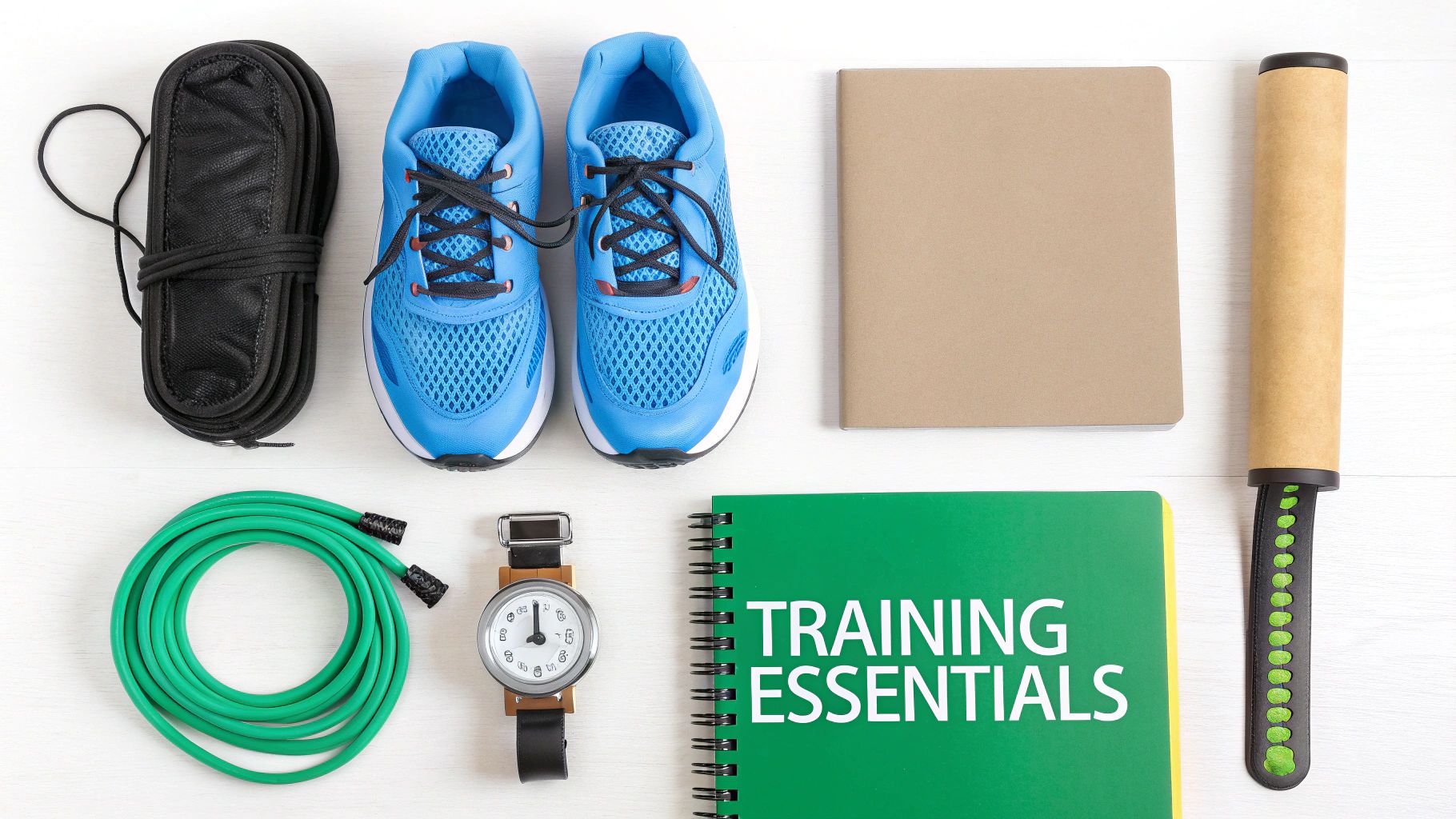
The Cornerstone of Endurance: The Long Run
The weekly long run is the undisputed king of half marathon training. Period. This is where your body makes the crucial adaptations it needs to go the distance. These slow, steady efforts aren't about speed; they're all about time on your feet.
During these runs, you're teaching your body to become a more efficient fat-burning machine, strengthening muscle fibers, and improving how well you deliver oxygen to your muscles. Every long run builds the physical durability and mental grit you'll lean on in the final, toughest miles of your race.
Honing Your Speed and Efficiency
While long runs build your stamina, speed work is what makes you faster and more economical. You don't have to live at the track, either. Just one or two faster sessions a week can make a massive difference in your performance and help you run closer to your potential, whatever your current average half marathon time is.
Here are the bread-and-butter speed workouts:
- Tempo Runs: Think "comfortably hard." This is a sustained effort, usually for 20-40 minutes, that feels challenging but controlled. Tempo runs are brilliant for teaching your body to clear out lactic acid more efficiently, which pushes back fatigue and makes your goal pace feel much more manageable on race day.
- Intervals: This is classic speed training: running short, fast repeats (like 400 or 800 meters) with recovery jogs in between. Intervals are fantastic for boosting your VO2 max—your body's maximum capacity to use oxygen—which is a huge marker of running fitness.
The Unsung Hero: Recovery and Support Work
Hard training breaks your body down. Recovery is what builds it back up stronger. Skipping this part is the fastest ticket to injury or burnout. Easy runs, often called recovery runs, are done at a super low intensity for a reason. They gently increase blood flow to tired muscles, helping to flush out metabolic waste and speed up repair without piling on more stress.
Running is only part of the equation. What you do on your "off" days—strength training, cross-training, and pure rest—is what solidifies your fitness and keeps you healthy for the long haul.
Strength training that targets your core, hips, and legs corrects muscle imbalances and cleans up your running form. This makes you a more powerful and injury-resistant athlete. Likewise, cross-training activities like swimming or cycling give you a great aerobic workout without the pounding of running, letting you build fitness while giving your joints a well-deserved break. It's all these pieces working together that create a balanced approach for a strong, successful race day.
Common Questions About Half Marathon Times Answered
Even after digging into all the data, you probably still have a few practical questions rattling around in your head. Let's tackle some of the most common ones that pop up when runners start thinking about their race.
Is Running a Half Marathon in Under 2 Hours a Good Time?
Absolutely. Finishing a half marathon in under 2 hours is a classic benchmark and a massive accomplishment for most runners. It's a goal that signifies a solid level of fitness and dedication.
To break that 2-hour barrier, you need to sustain an average pace of about 9 minutes and 9 seconds per mile (or 5:41 per kilometer). It's tough, for sure, but it’s a very achievable goal that puts you ahead of the pack in most recreational races.
How Long Does It Realistically Take to Train for a Half Marathon?
This really depends on where you're starting from, but a good rule of thumb for a beginner who just wants to finish strong is a 12 to 16-week training plan. That timeline gives your body enough time to adapt and build up the mileage safely, which is key to avoiding injury.
If you're a more seasoned runner chasing a new personal record, you'll likely follow a similar timeframe. The difference is that your training will be much more intense, packed with specific workouts like tempo runs and intervals.
What about the pros? Elite half marathon times are on a whole different level. For men, we're talking about anything under 1 hour and 5 minutes, with world records now dipping below 58 minutes. Elite women are phenomenally fast, often finishing under 1 hour and 10 minutes, with the world record hovering around 1 hour and 4 minutes.
What’s the Single Biggest Mistake Most Runners Make on Race Day?
Without a doubt, it's starting out way too fast. It's so easy to do! The race-day adrenaline is pumping, the crowd is cheering, and you feel like you can fly. But you end up burning through your glycogen stores way too early.
The smartest race strategy is to consciously hold back for the first few miles. Trust your training, stick to your goal pace, and save that energy for a powerful finish in the second half of the race. You'll be passing all the people who sprinted off the starting line.
Here at THE RUNNING, we have the expert advice and training plans to help you crush your first or your fastest half marathon. Check out all our resources and get started at https://www.the-running.com.



